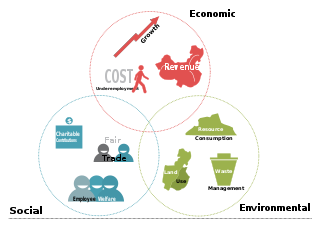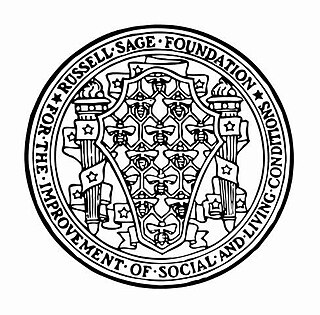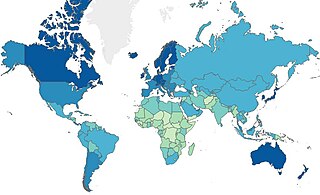Community indicators are a localized response to the perceived invalidity of the traditional predominantly economic indicators, such as GDP, that are used for measuring human progress. This invalidity takes two forms. First, economic indicators account for all money transactions as beneficial for quality of life, whereas some of these can be seen as decidedly negative (e.g., money spent on environmental cleanup of pollution that could have been prevented). Secondly, strictly economic indicators do not count the value of non-monetary activity, such as homemaker and volunteer work and non-cash public assistance, which are decidedly positive for the quality of life of many families (Journal article by David Swain, Danielle Hollar; International Journal of Public Administration, Vol. 26, 2003).
A communities level approach to this apparent invalidity is based on the evidence of a social group whose members reside in a specific locality, share government, and often have a common culture and history. Community indicators are not a new concept; they have been in use since 1910, when the Russell Sage Foundation initiated the development of local surveys for measuring industrial, educational, recreational, and other factors. The processes used by the Sage Foundation are similar to those that reemerged during the 1990s. But the difference today is the use of indicators to consider the full spectrum of a community’s well-being, not just isolated factors. Nowadays, indicators are used by many constituencies within a community. After a decade of renewed attention to community indicators, they now represent a valuable mechanism to improve monitoring and evaluation in planning.
Russell Sage Foundation employed “over two thousand local surveys taken on education, recreation, public health, crime, and general social conditions” to assess social conditions. The first survey was conducted in Pittsburgh, Pennsylvania. (In the late 1990s, Pittsburgh again embraced indicators, with its Sustainable Pittsburgh Goals and Indicators Project.) Many of the surveys used by the Sage Foundation were conducted by nonprofit organizations, such as chambers of commerce and citizen committees. These surveys yielded social trends indicators and were popular until the Great Depression and World War II, when economic measures such as the gross domestic product or gross national product indicators took greater precedence
Quality of life (QOL) is defined by the World Health Organization as "an individual's perception of their position in life in the context of the culture and value systems in which they live and in relation to their goals, expectations, standards and concerns".

The triple bottom line is an accounting framework with three parts: social, environmental and economic. Some organizations have adopted the TBL framework to evaluate their performance in a broader perspective to create greater business value. Business writer John Elkington claims to have coined the phrase in 1994.
Governance is the process of making and enforcing decisions within an organization or society. It encompasses decision-making, rule-setting, and enforcement mechanisms to guide the functioning of an organization or society. Effective governance is essential for maintaining order, achieving objectives, and addressing the needs of the community or members within the organization. Furthermore, effective governance promotes transparency, fosters trust among stakeholders, and adapts to changing circumstances, ensuring the organization or society remains responsive and resilient in achieving its goals. It is the process of interactions through the laws, social norms, power or language as structured in communication of an organized society over a social system. It is done by the government of a state, by a market, or by a network. It is the process of choosing the right course among the actors involved in a collective problem that leads to the creation, reinforcement, or reproduction of acceptable conduct and social order". In lay terms, it could be described as the processes that exist in and between formal institutions.

Genuine progress indicator (GPI) is a metric that has been suggested to replace, or supplement, gross domestic product (GDP). The GPI is designed to take fuller account of the well-being of a nation, only a part of which pertains to the size of the nation's economy, by incorporating environmental and social factors which are not measured by GDP. For instance, some models of GPI decrease in value when the poverty rate increases. The GPI separates the concept of societal progress from economic growth.

The Canadian Index of Wellbeing (CIW) is a composite index, composed of eight interconnected domains that measures stability and change in the wellbeing of Canadians over time. The CIW describes wellbeing as, "The presence of the highest possible quality of life in its full breadth of expression, focused on but not necessarily exclusive to: good living, standards, robust health, a sustainable environment, vital communities, an educated populace, balanced time use, high levels of democratic participation, and access to and participation in leisure and culture". The CIW acts as a companion measure of societal progress to the Gross Domestic Product (GDP), which is based solely upon economic productivity.

The Russell Sage Foundation is an American non-profit organisation established by Margaret Olivia Sage in 1907 for “the improvement of social and living conditions in the United States.” It was named after her recently deceased husband, railroad executive Russell Sage. The foundation dedicates itself to strengthening the methods, data, and theoretical core of the social sciences in order to better understand societal problems and develop informed responses. It supports visiting scholars in residence and publishes books and a journal under its own imprint. It also funds researchers at other institutions and supports programs intended to develop new generations of social scientists. The foundation focuses on labor markets, immigration and ethnicity, and social inequality in the United States, as well as behavioral economics.
The term "sustainable communities" has various definitions, but in essence refers to communities planned, built, or modified to promote sustainable living. Sustainable communities tend to focus on environmental and economic sustainability, urban infrastructure, social equity, and municipal government. The term is sometimes used synonymously with "green cities," "eco-communities," "livable cities" and "sustainable cities."

Livability or liveability is the degree to which a place is good for living. Livability refers to the concerns that are related to the long-term wellbeing of individuals and communities. It encompasses factors like neighborhood amenities, including parks, open space, walkways, grocery shops and restaurants as well as environmental quality, safety and health. It also incorporates things like cost and friendliness. These features contribute to the pleasantness and accessibility of communities. Additionally, livability considers the availability and quality of public transport, educational institutions and healthcare facilities. It also considers the overall cultural and social atmosphere of a place, including the presence of diverse recreational activities and community engagement opportunities. All these factors combined create an environment that enhances the overall quality of life for residents.

The Happy Planet Index (HPI) is an index of human well-being and environmental impact that was introduced by the New Economics Foundation in 2006. Each country's HPI value is a function of its average subjective life satisfaction, life expectancy at birth, and ecological footprint per capita. The exact function is a little more complex, but conceptually it approximates multiplying life satisfaction and life expectancy and dividing that by the ecological footprint. The index is weighted to give progressively higher scores to nations with lower ecological footprints.
Ecologically sustainable development is the environmental component of sustainable development. It can be achieved partially through the use of the precautionary principle; if there are threats of serious or irreversible environmental damage, lack of full scientific certainty should not be used as a reason for postponing measures to prevent environmental degradation. Also important is the principle of intergenerational equity; the present generation should ensure that the health, diversity and productivity of the environment is maintained or enhanced for the benefit of future generations. In order for this movement to flourish, environmental factors should be more heavily weighed in the valuation of assets and services to provide more incentive for the conservation of biological diversity and ecological integrity.
A needs assessment is a systematic process for determining and addressing needs, or "gaps", between current conditions and desired conditions or "wants".
Sustainability metrics and indices are measures of sustainability, and attempt to quantify beyond the generic concept. Though there are disagreements among those from different disciplines, these disciplines and international organizations have each offered measures or indicators of how to measure the concept.

Sustainability is a social goal for people to co-exist on Earth over a long time. Specific definitions of this term are disputed and have varied with literature, context, and time. Experts often describe sustainability as having three dimensions : environmental, economic, and social, and many publications emphasize the environmental dimension. In everyday use, sustainability often focuses on countering major environmental problems, including climate change, loss of biodiversity, loss of ecosystem services, land degradation, and air and water pollution. The idea of sustainability can guide decisions at the global, national, and individual levels. A related concept is sustainable development, and the terms are often used to mean the same thing. UNESCO distinguishes the two like this: "Sustainability is often thought of as a long-term goal, while sustainable development refers to the many processes and pathways to achieve it."

Sustainability measurement is a set of frameworks or indicators to measure how sustainable something is. This includes processes, products, services and businesses. Sustainability is difficult to quantify. It may even be impossible to measure. To measure sustainability, the indicators consider environmental, social and economic domains. The metrics are still evolving. They include indicators, benchmarks and audits. They include sustainability standards and certification systems like Fairtrade and Organic. They also involve indices and accounting. And they can include assessment, appraisal and other reporting systems. These metrics are used over a wide range of spatial and temporal scales. Sustainability measures include corporate sustainability reporting, Triple Bottom Line accounting. They include estimates of the quality of sustainability governance for individual countries. These use the Environmental Sustainability Index and Environmental Performance Index. Some methods let us track sustainable development. These include the UN Human Development Index and ecological footprints.

The Ibrahim Index of African Governance (IIAG), established in 2007, provides an assessment of the quality of governance in African countries. The IIAG is compiled by 81 indicators and 265 variables from 54 data projects, coming from 47 independent African and international data sources. Published every two years, the IIAG is one of the world’s most comprehensive collections of data on African governance.
A sustainability organization is (1) an organized group of people that aims to advance sustainability and/or (2) those actions of organizing something sustainably. Unlike many business organizations, sustainability organizations are not limited to implementing sustainability strategies which provide them with economic and cultural benefits attained through environmental responsibility. For sustainability organizations, sustainability can also be an end in itself without further justifications.
The OECD Better Life Index, created in May 2011 by the Organisation for Economic Co-operation and Development, is an initiative pioneering the development of economic indicators which better capture multiple dimensions of economic and social progress.
Although for many decades, it was customary to focus on GDP and other measures of national income, there has been growing interest in developing broad measures of economic well-being. National and international approaches include the Beyond GDP programme developed by the European Union, the Better Lives Compendium of Indicators developed by the OECD, as well as many alternative metrics of wellbeing or happiness. One of the earliest attempts to develop such an index at national level was Bhutan's Gross National Happiness Index and there are a now a number of similar projects ongoing around the world, including a project to develop for the UK an assessment of national well-being, commissioned by the Prime Minister David Cameron and led by the Office for National Statistics.

Circles of Sustainability is a method for understanding and assessing sustainability, and for project management directed towards socially sustainable outcomes. It is intended to handle 'seemingly intractable problems' such as outlined in sustainable development debates. The method is mostly used for cities and urban settlements.

The Social Progress Index (SPI) measures the extent to which countries provide for the social and environmental needs of their citizens. Fifty-four indicators in the areas of basic human needs, foundations of well-being, and opportunity to progress show the relative performance of nations. The index is published by the nonprofit Social Progress Imperative, and is based on the writings of Amartya Sen, Douglass North, and Joseph Stiglitz. The SPI measures the well-being of a society by observing social and environmental outcomes directly rather than the economic factors. The social and environmental factors include wellness, equality, inclusion, sustainability and personal freedom and safety.










